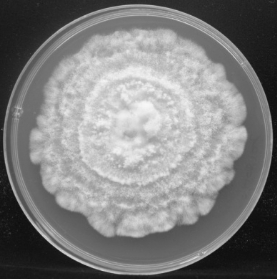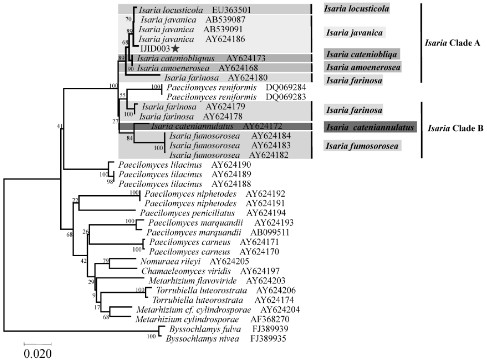A Strain of I. japonicum Effective in Controlling Scale Insects
A technology for coryneform spores and scale insects, which is applied in the field of biological pest control and achieves the effects of good market application prospects, fast growth speed and large spore production.
- Summary
- Abstract
- Description
- Claims
- Application Information
AI Technical Summary
Problems solved by technology
Method used
Image
Examples
Embodiment 1
[0037] Example 1 Isolation of I. javanica strain IJID003
[0038] The highly pathogenic fungus was isolated from naturally susceptible Coccoccus aegypti from Bailan in Yuexiu Park, Guangzhou City, Guangdong Province. The method is as follows:
[0039] (1) Isolation of fungi
[0040] The hyphae were picked from the susceptible Coccoccus aegyptis, inoculated on PDA medium for cultivation, and cultivated at 27±1°C for 7 days. The hyphae were picked from the center of the formed colony, purified and cultured on PDA medium, and the purified culture was repeated 3 times, and placed in a 4°C refrigerator for use.
[0041] (2) Fungal inoculation experiment
[0042] Cultivate the isolated fungus on a PDA plate for 7 to 15 days. After the formation of colonies, add 0.02% Tween-80 sterile water to wash the spores, stir on a magnetic stirrer for 15 minutes, and adjust the spore concentration to 1 with a hemocytometer. ×10 7 spores / mL to prepare the spore suspension, use a small manual...
Embodiment 2
[0045] Example 2 Screening of I. javanica strain IJID003
[0046] Entomopathogenic fungi are diverse in terms of genetics, ecology, and biology, and different strains of fungi show significant differences in the pathogenicity of target pests. The screening and acquisition of high-yield and high-quality strains is the first prerequisite for better control effects. The selection of excellent strains mainly considers three indicators, namely sporulation, colony growth rate, and pathogenicity. The present invention uses these three indexes as the main basis to screen excellent highly pathogenic bacterial strains.
[0047] (1) Material preparation
[0048] Eight isolates of purified IJID001, IJID002, IJID003, IJID004, IJID005, IJID006, IJID007, and IJID008 were cultured on PDA plates in a constant temperature incubator at 27±1°C.
[0049] (2) Tested insects and host plants
[0050] Coccus edulis in Egypt came from the subcultured population on the white orchid in the greenhouse...
Embodiment 3
[0065] Identification of embodiment 3 bacterial strain IJID003
[0066] (1) Morphological characteristics of strain IJID003
[0067] The strain IJID003 was inoculated into the center of the PDA medium plate, placed in a constant temperature culture at 27±1°C, and the growth of the colony was observed every day and the color and shape of the colony were recorded. Inoculate the strain IJID003 into the center of another PDA medium plate, insert the sterilized coverslip (1cm×1cm) obliquely into the medium about 1cm away from the inoculation point, and culture at a constant temperature of 27±1°C for 5 days Wait until the hyphae extend to the cover glass, take out the cover glass and place it under an optical microscope to observe the morphology of the hyphae and spores.
[0068] Morphological characteristics of strain IJID003 ( figure 1 and figure 2 ): On the PDA plate, the colony is round, with a diameter between 49mm and 55mm, with concentric ring patterns, and forms grooves ...
PUM
| Property | Measurement | Unit |
|---|---|---|
| diameter | aaaaa | aaaaa |
| diameter | aaaaa | aaaaa |
Abstract
Description
Claims
Application Information
 Login to View More
Login to View More - R&D
- Intellectual Property
- Life Sciences
- Materials
- Tech Scout
- Unparalleled Data Quality
- Higher Quality Content
- 60% Fewer Hallucinations
Browse by: Latest US Patents, China's latest patents, Technical Efficacy Thesaurus, Application Domain, Technology Topic, Popular Technical Reports.
© 2025 PatSnap. All rights reserved.Legal|Privacy policy|Modern Slavery Act Transparency Statement|Sitemap|About US| Contact US: help@patsnap.com



